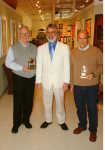Civil War Memorial restoration will require attention to detail

To the untrained eye, the rare Civil War Monument in Greencastle's Forest Hill Cemetery seems like a basic towering limestone structure.
It is so much more than that, however, consulting engineer Fritz Herget of Arsee Engineers Inc. told two dozen members of the Heritage Preservation Society during the organization's annual meeting Thursday evening at the Putnam County Museum.
It won't, however, be a simple monument to restore, he said.
But it could be as easy as one-two-three.
For the 143-year-old memorial is a three-tier structure, the bottom portion of which is made of classic Indiana limestone.
"Oolitic limestone," the engineer clarifies. "You're going to find that all around Greencastle. It was used extensively in foundations, and it's done a pretty good job. After all, it's been there 150 years."
Hoosier quarries have long contributed like material for such landmarks as The Pentagon and the Empire State Building. The Soldiers and Sailors Monument in downtown Indianapolis -- for which Herget served as a consultant during its recent restoration effort -- is also composed mainly of Indiana limestone.
So it's understandable that the 29-foot-tall local monument -- which bears names of 321 Putnam County soldiers who perished in the Civil War -- have a base of such sovereign material.
Meanwhile, the center section of the monument -- titled "Western Soldier on Guard" and sculpted by Thomas David Jones (who essentially erected a twin monument in Pomeroy, Ohio) -- is made of Berea sandstone, quarried from a specific area of Ohio that no longer provides such material.
So repairs to that section could be a little dicey, Herget warned.
"I don't think we can find a quarry to reopen to get that sandstone," he said with a grin.
The upper section of the monument appears to be another sandstone variety, he said.
While it looks to be harder than the middle section material, it is not the same, Herget said. "I'm not sure what that stuff on the top is," he added.
So repairing it could take some ingenuity.
"We might be able to harvest the material we need (for repairs) from the monument itself," he suggested, noting that one stone in the 1870 structure is "absolutely pristine."
"I'm here to try and help you," Herget confided in his role of consultant on the restoration project.
He also set the record straight on the notion that the monument in the southwest corner of the Greencastle cemetery might be hollow inside. That's just not possible, Herget suggested.
"Our soldier up there is a huge weight," he said. "He weighs more than a car."
So if the monument were indeed hollow, Herget said, that seated soldier "would have fallen in by now."
The cavalry soldier atop the monument is rare among Civil War period pieces. In fact, the monument is considered the earliest Indiana example of a military figure appearing on a Civil War memorial.
"There is no other figure like him in the state," the website Sculptural Civil War Monuments in Indiana notes, referring to the noble figure as "the unusually seated cavalry soldier."
The soldier is considered a "faithful portrayal of a Civil War volunteer," according to documents from the dedication ceremony that took place July 2,1870 before an estimated 8,000 people (an incredible number considering fewer than half that many actually lived in Greencastle at the time).
In reporting on the monument restoration project, former HPS president Phil Gick noted the establishment of a Civil War Monument Restoration Pass Through Fund at the Putnam County Community Foundation.
The account, to which individuals are able to direct donations directly for the assessment, stabilization and restoration of the monument, currently has a balance of $14,543.
Gick noted that $12,500 will be needed to do an assessment of the structure and produce bid documents for the stabilization and restoration of the monument. It has been estimated that another $50,000 or more will be necessary to affect the restoration.
"I've had people ask," Gick said, "'Do we still need money?' Yes, and when we get past that phase (stabilization), we're going to need even more money for restoration."
Herget indicated quantifying the restoration project is still an inexact science because of the uncertainty involved.
"I wish I could tell you that you'll spend $48,523 and this thing will be here for 300 generations," the engineering expert noted.
But like he said, it just isn't that easy ...
